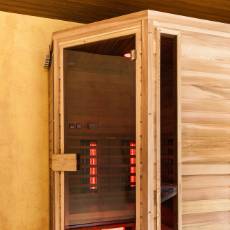Keep in mind types, sizing, seating, construction and safety when considering an indoor sauna.
Indoor saunas provide the ultimate solution for relaxation and stress relief. Anyone who has ever envisioned coming home at the end of the day to an inviting sauna or Swedish bath experience can appreciate the concept of installing an indoor sauna. Using a sauna can help detoxify and cleanse the body, clear up skin problems and stimulate circulation.

Indoor saunas or steam rooms usually come in prefabricated pieces that the homeowner puts together on-site, although some may be cabin style and already assembled.
Typically, saunas are built using aromatic wood species, like cedar, which can add a spa-like touch to the sauna experience.
On today's market, there are indoor saunas in all price ranges and styles.
The most common types include:
- Infrared indoor saunas. This type of sauna emits infrared beams that provide heat to the body without heating the air around the body. Infrared heat penetrates the uppermost layer of skin, relaxing sore muscles and warming body tissues. This type of sauna is ideal for use as a therapeutic heat treatment for conditions like arthritis or for alleviating the pain associated with certain muscle conditions and tissue injuries.
- Electric indoor saunas. An electric indoor sauna features a heating element that produces heat using stones or wood. This type of sauna warms the body and the air surrounding it.
- Gas indoor saunas. A gas-powered indoor sauna relies on natural or petroleum gas to increase humidity and temperature and is among the most energy-efficient saunas.
When selecting the right sauna or Finnish sauna for your needs, you will also want to consider the size of the sauna. Many people install an indoor sauna in a spare bedroom or basement. There are also small saunas whose sizes are just right for the master bathroom suite.
Safety features are also important when selecting your sauna or sweathouse. Always look for an indoor sauna that has a clear temperature monitor that can help you check heat levels. Ideally, your sauna should have an indicator light that will alert you to when the humidity or heat within the sauna reaches a level that might be harmful.
Related reading:
- Add a bathroom to your home
- DIY saunas: points to consider
- Outdoor saunas: an overview of options
- Saunas for the home: indoor or outdoor
Be sure that the door to the sauna swings out, not in. This helps ensure that no one will be trapped inside the sauna.
Seating is another consideration when buying your indoor sauna. Seats should be sufficiently wide, comfortable and sturdy to accommodate the number of people who will be using the sauna regularly. Two-level seating will allow you to make the most use of the wall space within the sauna.
If you have basic do-it-yourself (DIY) skills, you can likely install an indoor sauna from a kit over the course of a weekend. If you are not comfortable with installing indoor saunas on your own, QualitySmith can help you find a professional installer in your area to do the job for you.













Write a Comment